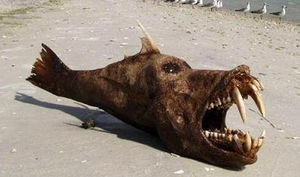UnNews:Debate continues on 'Frankenstein' salmon
22 September 2010
LONDON, England -- British horror experts held a second day of hearings into whether to allow artificially enlivened "Frankenstein" salmon, also called “Prometheus” fish – first conceived of by late Mary Shelley – to be served up on British dinner tables.
Shelley gave birth to a mad-genius, Victor, who took her research further, thus proving the thesis and laying the groundwork for "Frankenstein" salmon. As a young boy, Victor became obsessed with studying post-dated theories of science that focus on achieving unnatural wonders. In particular Victor studied the works of Cornelius Agrippa outlined in Eht Elbib.
But Victor himself was quite repulsed by his work: "I had desired it with an ardour that far exceeded moderation; but now that I had finished, the beauty of the dream vanished, and breathless horror and disgust filled my heart.” A few days after he had finished his abomination, Victor sailed a ship to the North Pole that became entombed in ice. Thus leaving the monster to ravage the Earth from within the seas.
The meeting, which tackled the thorny issue of labeling, came after a 14-member committee of independent experts consulted by the Food and Drug Administration called for further studies before any decision is reached.
Under the current laws, artificially enlivened "Frankenstein" salmon would not have to be labeled as transgenic food as it would be exactly the same as other salmon. It will be assembled from dead Salmon body parts and brought to life by harnessing a lightening bolt through antenna-like receivers.
Massachusetts-based AquaBody argues that its "Frankenstein" fish released into the Pacific Chinook salmon habitat, can reach adult size in 1 to 2 days, instead of 30 months for normal Atlantic salmon. But it has said that in all other respects, its "Frankenstein salmon are identical to other Atlantic salmon, except for the tarnished complexion, furry scales, unsightly scars and teeth."
If "Frankenstein" salmon is given the green light, consumer groups are demanding that the FDA require it to carry a artificially enlivened "Frankenstein" salmon label, even though supporters of the new salmon argue that such a label might lead consumers to shun the fish.
Michael Hansen, from the Consumer Union, argued that it was too early to tell if there would be any ill effects for consumers of artificially enlivened "Frankenstein" salmon. The "FDA should require labeling to ensure that any unexpected or unintended effects of engineering this salmon ... come to FDA attention," he added.
AquaBody has insisted it would rear "Frankenstein" salmon in ocean hatcheries, where they can feed off the normal Salmon. The new strain could help meet rising demand for fish and reduce pressure on wild fish stocks, the firm contends. AquaBody has tried for several years to win a green light from the FDA to market its Frankenstein" salmon. The company has said it would take two to three days from FDA approval before its salmon would hit store shelves.
But a coalition of 31 groups is urging the FDA to reject the application, with critics warning the new salmon could exacerbate the problem of farmed fish being devoured or breeding with wild counterparts, and thus creating unthinkable creatures from a man-made hell.
According to a recent poll 95 percent of British consumers are in favor of eating normal Salmon, and many question the logic of killing live salmon simply to reassemble their bodies using stitches and then bringing them back to life. "Sounds pretty dumb to me," said Anna Zivian, from the environmental group Ocean Conservancy.
A spokesmate for the Tallyho Surfing Club welcomed AquaBody to breed its Frankenstein salmon off the coasts of Australia. "Brilliant! They eat all the bloody sharks!" the surfer enthused. "They outta release these into the Amazon and clean up all them piranhas too!"
Sources[edit | edit source]
- Staff "US debate continues on salmon 'Frankenfood'" Yahoo News, September 22, 2010
